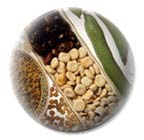- Home
- Introductions

|
Vegetable Seed Production
Chicory :: Endive :: Globe
Artichoke :: Lettuce |
 |
Common Name: Chicory Scientific Name: Cichorium intybus Family: Asteraceae |
Chicory introduction & history
Many diverse and distinct forms exist in this species. The green leafy vegetable that resembles dandelion is called foliage chicory and is popular in some parts of Europe. Cultivars that produce a small red to green colored head are called radicchio. Cultivars that are forced to produce narrow leafy heads called a chicon are called Witloof, Witloof chicory, French endive, Belgium endive. All of the leafy forms of chicory tend to have a bitter flavor that is not liked by many Americans. Chicory roots may also be used as an adulterant and/or substitute for coffee.
Probably native to Asia and for Mediterranean Europe and probably used as a non-cultivated salad plant for centuries.
Chicory Seed Identification page
 |
Common Name: Endive Scientific Name: Cichorium endivia Family: Asteraceae |
Endive introduction & history
Not a type of lettuce as commonly advertised in the grocery but a distinct vegetable from a different genus and closely related to chicory. Endive is grown for use as a salad ingredient either added to and/or taking the place of lettuce. Broad leaved cultivars are occasionally used as potherbs in stews or soups. Many people dislike the slight bitterness of endive, others favor it.
Endive is somewhat more tolerant to heat than lettuce. Relatively easy to grow, yet it is not a very popular vegetable and US production is quite limited.
The crop is grown much like lettuce and rapid continuous growth is encouraged to assure tender crisp leaves. Years ago, the leaves were blanched, supposedly to reduce bitterness, increase tenderness and appearance. This was done by tying outer leaves together to cover the crown or by covering the plants with straw, etc.
Thought to be East Indian in origin. Eaten by Egyptians and Greeks long before the Christian era.
Endive Seed Identification page
 |
Common Name: Globe
Artichoke Scientific Name: Cynara scolymus Family: Asteraceae |
Globe Artichoke introduction & history
Globe artichoke (also known as green artichoke or French artichoke) is a cool season herbaceous perennial dicot grown for its immature flower bud called a capitulum
Each mature plant will produce 5 to 8 marketable buds per season and a few smaller buds that are not marketable.
Acclimated plants can survive low temperatures of 20 F with little damage, but flower buds can be damaged at 30 F
The edible portions of the bud are the tender bases of the bracts and the fleshy receptacle (heart).
At full maturity, artichoke plants can be 4-5 feet tall and 5-6 feet in diameter.
Globe artichokes were apparently popular in second century Rome, but it was not until 1400 A.D. that the first records of the production of modern globe artichoke cultivars were recorded in Naples, Italy. Globe artichokes were introduced by early colonists from France and Italy. Thomas Jefferson was fond of globe artichokes after he lived in France as the French Ambassador and grew them at Monticello in the early 19th century.
Globe Artichoke Seed Identification page
 |
Common Name: Lettuce Scientific Name: Lactuca sativa Family: Asteraceae |
Lettuce introduction & history
Tall annual and perennial herbs, mostly from the northern hemisphere, about 100 species, most are weeds. Leaves are alternate and variable and flower heads borne on small long irregular panicles. Achenes oval to linear, flat, plainly 3-5 ribbed on either side, a soft, thin white or brown pappus is elevated on a beak.
As judged by paintings of leaves identified as lettuce in some Egyptian tombs, it appears lettuce was cultivated as far back as 4500 BC. These paintings further suggest that it was a common crop widely known and appreciated. The leaves appear to represent those of the Romaine type.
Lettuce spread throughout the Mediterranean basin at an early date. Numerous Greek and Roman references cite its use. Lettuce was probably spread via Romans to the rest of Europe. Post Columbus movement brought lettuce from Europe to the New World.
Most types of commercial lettuce, and particularly crisphead types, have been genetically modified by human selection or plant breeding so they can no longer survive as wild plants. Early selection by humans probably was based on non-shattering, delayed bolting, non-spininess, decrease in latex (white sap), increased seed size, and heading characteristics. Selection for greater bolting resistance and resistance to disease was relatively recent.
Therefore, cultivated lettuce has an uncertain origin since it does not exist in the wild. Modern lettuce is believed to be derived from L. serriola. The sativa-serriola complex is large, polymorphic, and capable of free interchange of genes with little or no reduction in fertility. L. sativa may have been derived directly from L. serriola through selection.
Lettuce Seed Production and Identification page